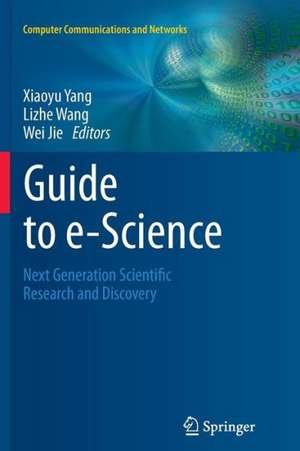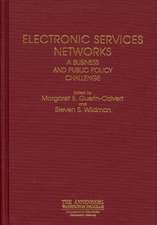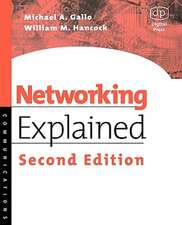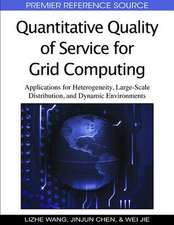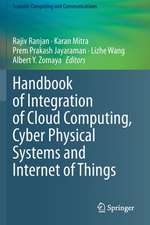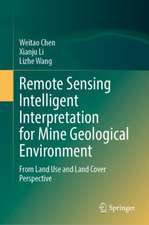Guide to e-Science: Next Generation Scientific Research and Discovery: Computer Communications and Networks
Editat de Xiaoyu Yang, Lizhe Wang, Wei Jieen Limba Engleză Paperback – 15 iul 2013
| Toate formatele și edițiile | Preț | Express |
|---|---|---|
| Paperback (1) | 902.04 lei 38-44 zile | |
| SPRINGER LONDON – 15 iul 2013 | 902.04 lei 38-44 zile | |
| Hardback (1) | 1006.95 lei 43-57 zile | |
| SPRINGER LONDON – 27 mai 2011 | 1006.95 lei 43-57 zile |
Din seria Computer Communications and Networks
- 20%
 Preț: 378.19 lei
Preț: 378.19 lei - 20%
 Preț: 684.74 lei
Preț: 684.74 lei - 20%
 Preț: 218.22 lei
Preț: 218.22 lei - 20%
 Preț: 1013.39 lei
Preț: 1013.39 lei - 20%
 Preț: 368.78 lei
Preț: 368.78 lei - 20%
 Preț: 505.49 lei
Preț: 505.49 lei - 20%
 Preț: 646.80 lei
Preț: 646.80 lei - 20%
 Preț: 609.09 lei
Preț: 609.09 lei - 20%
 Preț: 765.60 lei
Preț: 765.60 lei - 20%
 Preț: 339.47 lei
Preț: 339.47 lei - 20%
 Preț: 597.29 lei
Preț: 597.29 lei - 20%
 Preț: 655.85 lei
Preț: 655.85 lei - 20%
 Preț: 997.06 lei
Preț: 997.06 lei - 20%
 Preț: 351.89 lei
Preț: 351.89 lei - 20%
 Preț: 996.22 lei
Preț: 996.22 lei - 20%
 Preț: 644.81 lei
Preț: 644.81 lei - 15%
 Preț: 650.69 lei
Preț: 650.69 lei - 20%
 Preț: 650.73 lei
Preț: 650.73 lei - 20%
 Preț: 373.91 lei
Preț: 373.91 lei - 20%
 Preț: 646.95 lei
Preț: 646.95 lei - 20%
 Preț: 1004.99 lei
Preț: 1004.99 lei - 20%
 Preț: 646.80 lei
Preț: 646.80 lei - 20%
 Preț: 341.81 lei
Preț: 341.81 lei - 20%
 Preț: 656.19 lei
Preț: 656.19 lei - 20%
 Preț: 651.75 lei
Preț: 651.75 lei - 20%
 Preț: 331.08 lei
Preț: 331.08 lei - 20%
 Preț: 650.40 lei
Preț: 650.40 lei - 20%
 Preț: 988.66 lei
Preț: 988.66 lei - 20%
 Preț: 643.97 lei
Preț: 643.97 lei - 20%
 Preț: 761.44 lei
Preț: 761.44 lei - 20%
 Preț: 332.71 lei
Preț: 332.71 lei - 20%
 Preț: 345.59 lei
Preț: 345.59 lei - 20%
 Preț: 332.06 lei
Preț: 332.06 lei - 20%
 Preț: 996.22 lei
Preț: 996.22 lei - 20%
 Preț: 644.15 lei
Preț: 644.15 lei - 20%
 Preț: 326.64 lei
Preț: 326.64 lei - 20%
 Preț: 320.19 lei
Preț: 320.19 lei - 20%
 Preț: 1013.06 lei
Preț: 1013.06 lei - 20%
 Preț: 642.52 lei
Preț: 642.52 lei - 20%
 Preț: 641.01 lei
Preț: 641.01 lei - 20%
 Preț: 718.56 lei
Preț: 718.56 lei - 20%
 Preț: 1043.41 lei
Preț: 1043.41 lei
Preț: 902.04 lei
Preț vechi: 1127.55 lei
-20% Nou
Puncte Express: 1353
Preț estimativ în valută:
172.63€ • 179.56$ • 142.51£
172.63€ • 179.56$ • 142.51£
Carte tipărită la comandă
Livrare economică 09-15 aprilie
Preluare comenzi: 021 569.72.76
Specificații
ISBN-13: 9781447126584
ISBN-10: 1447126580
Pagini: 568
Ilustrații: XXVIII, 540 p.
Dimensiuni: 155 x 235 x 30 mm
Greutate: 0.79 kg
Ediția:2011
Editura: SPRINGER LONDON
Colecția Springer
Seria Computer Communications and Networks
Locul publicării:London, United Kingdom
ISBN-10: 1447126580
Pagini: 568
Ilustrații: XXVIII, 540 p.
Dimensiuni: 155 x 235 x 30 mm
Greutate: 0.79 kg
Ediția:2011
Editura: SPRINGER LONDON
Colecția Springer
Seria Computer Communications and Networks
Locul publicării:London, United Kingdom
Public țintă
Professional/practitionerCuprins
Part I: Sharing and Open Research.- Implementing a Grid / Cloud e-Science Infrastructure for Hydrological Sciences.- The German Grid Initiative.- Democratizing Resource-Intensive e-Science Through Peer-to-Peer Grid Computing.- Peer4Peer: E-science Communities for Overlay Network and Grid Computing Research.- Part II: Data-Intensive e-Science.- A Multi-Disciplinary, Model-Driven, Distributed Science Data System Architecture.- An Integrated Ontology Management and Data Sharing Framework for Large-Scale Cyberinfrastructure.- Part III: Collaborative Research.- An e-Science Cyberinfrastructure for Solar-enabled Water Production and Recycling.- e-Science Infrastructure Interoperability Guide.- Trustworthy Distributed Systems Through Integrity-Reporting.- An Intrusion Diagnosis Perspective on Cloud Computing.- Part IV: Research Automation, Reusability, Reproducibility and Repeatability.- Conventional Workflow Technology for Scientific Simulation.- Facilitating E-Science Discovery Using Scientific Workflows on the Grid.- Concepts and Algorithms of Mapping Grid-Based Workflows to Resources Within an SLA Context.- Orchestrating e-Science with the Workflow Paradigm.- Part V: e-Science: Easy Science.- Face Recognition using Global and Local Salient Features.- OGSA-Based SOA for Collaborative Cancer Research.- e-Science.
Textul de pe ultima copertă
The way in which scientific research is carried out is undergoing a series of radical changes, worldwide, as a result of the digital revolution. However, this “Science 2.0” requires a comprehensive supporting cyber-infrastructure.
This essential guidebook on e-science presents real-world examples of practices and applications, demonstrating how a range of computational technologies and tools can be employed to build essential infrastructures supporting next-generation scientific research. Each chapter provides introductory material on core concepts and principles, as well as descriptions and discussions of relevant e-science methodologies, architectures, tools, systems, services and frameworks. The guide’s explanations and context present a broad spectrum of different e-science system requirements.
Topics and features:
Dr. Xiaoyu Yang is a research engineer in theSchool of Electronics and Computer Science at the University of Southampton, UK. Dr. Lizhe Wang is a research scientist in the Pervasive Technology Institute at Indiana University, Bloomington, IN, USA. Dr. Wei Jie is a lecturer in the School of Computing at Thames Valley University, London, UK.
This essential guidebook on e-science presents real-world examples of practices and applications, demonstrating how a range of computational technologies and tools can be employed to build essential infrastructures supporting next-generation scientific research. Each chapter provides introductory material on core concepts and principles, as well as descriptions and discussions of relevant e-science methodologies, architectures, tools, systems, services and frameworks. The guide’s explanations and context present a broad spectrum of different e-science system requirements.
Topics and features:
- Includes contributions from an international selection of preeminent e-science experts and practitioners
- Discusses use of mainstream grid computing and peer-to-peer grid technology for “open” research and resource sharing in scientific research
- Presents varied methods for data management in data-intensive research
- Investigates issues of e-infrastructure interoperability, security, trust and privacy for collaborative research
- Examines workflow technology for the automation of scientific processes, and that ensures the research can be reusable, reproducible and repeatable
- Describes applications of e-science, highlighting systems used in the fields of biometrics, clinical medicine, and ecology
Dr. Xiaoyu Yang is a research engineer in theSchool of Electronics and Computer Science at the University of Southampton, UK. Dr. Lizhe Wang is a research scientist in the Pervasive Technology Institute at Indiana University, Bloomington, IN, USA. Dr. Wei Jie is a lecturer in the School of Computing at Thames Valley University, London, UK.
Caracteristici
Includes contributions from an international selection of preeminent e-science experts and practitioners Examines how e-science techniques can be used to facilitate “open” research and resource sharing, data-intensive research, collaborative research, and scientific workflows Describes applications of e-science, highlighting systems used in the fields of biometrics, clinical medicine, and ecology
